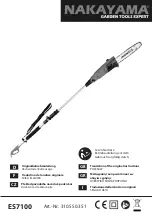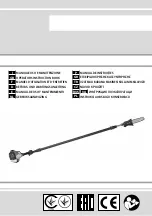
4
WARNING
Do not touch blade immediately
after use. Blade will be hot.
Changing Blades
1. REMOVE BATTERY PACK BEFORE CHANG-
ING OR REMOVING BLADES.
2. Turn the tension lock handle located on the front
of the saw 180° counterclockwise. This releases
the tension on the blade for easy removal.
3. Remove the
from the guides.
4. To install a new blade, with the pulleys facing up,
insert the blade between the rollers and the faces
of the guides, making sure that the teeth on the left
side of the tool point towards the rear of the tool.
5. With one hand, hold the blade in place between
the rollers and the guides and use the other hand
to position the blade around the pulleys. Be sure
that the blade lies freely within the guard channel
before starting the tool motor.
6. Turn the tension lock handle 180° clockwise to lock
the position. This will secure the blade on the pulleys.
BE SURE THAT THE BLADE IS PROPERLY
SEATED ON THE PULLEYS BEFORE START-
ING THE CUT.
Adjusting the 3-Position Material Guide
1. Remove the battery pack.
2. Press in the guide adjustment button and slide the
material guide to the desired position detent.
LED Worklight
The LED worklight is turned on automatically when
the trigger is pulled. To turn on the LED to line-up
a cut or light-up the workpiece, press the LED On
30 seconds.
OPERATION
WARNING
To reduce the risk of injury, always
remove battery pack before chang-
ing or removing accessories. Only use acces-
Others may be hazardous.
Always wear proper eye protection.
When working in dusty situations, wear
appropriate respiratory protection or use a dust
extraction solution.
Trigger Lock
To
lock
the trigger, push the trigger lock to the right.
The trigger will not work while the switch is in the
locked position. Always lock the trigger and remove
the battery pack before performing maintenance and
when changing accessories. Lock the trigger when
storing the tool and when the tool is not in use.
Speed Dial
These Band Saws have a speed dial located on
the side of the handle to set the maximum speed.
Rotate the speed dial to “5” for maximum speed, “1”
for minimum speed.
Starting and Stopping
This band saw requires both triggers to be pulled
at all times during use. If either trigger is released,
the tool will stop. Release both triggers and restart
the tool.
1. To
start
ASSEMBLY
WARNING
Recharge only with the charger
-
manual supplied with your charger and battery.
Removing/Inserting the Battery
To
remove
the battery, push in the release buttons
and pull the battery pack away from the tool.
WARNING
Always remove battery pack before
changing or removing accessories.
To
insert
the battery, slide the pack into the body
of the tool. Make sure it latches securely into place.
WARNING
recommended for this tool. Others
may be hazardous.
Blades and Blade Selection
The blade dimensions required for this band saw are:
.5mm thickness, 12.7mm width and 1139.8mm in length.
special 0.5mm thickness reduces flexure fatigue and
in length. The
provides maximum tooth life. To maximise cutting life,
use a blade with the correct pitch (teeth per inch) for
Blades are available in several pitches. To select the
proper blade, three factors should be considered: The
size, shape, and type of material to be cut.
The following suggestions are for selecting the right
blade for various cutting operations. Keep in mind
that these are broad guidelines and that blade re-
size, shape and type of material to be cut. Generally,
soft materials require coarse pitch blades and hard
work. It is important to keep at least three teeth in
the cut (see "Typical Application").
• For tough stock 13mm to
86mm in diameter or width
(available in carbon steel only).
• For tough stock 10mm to
25.4mm in diameter or width
(available in carbon steel only).
• For tough stock 5mm up to
120mm in diameter or width.
• For tough stock 4mm to19mm
in diameter or width.
• For thin-wall tubing and
thin sheets heavier than 21
gauge.
• For thin-wall tubing and
thin sheets heavier than 21
gauge.
6 Teeth per Inch
8 Teeth per Inch
10 Teeth per Inch
14 Teeth per Inch
18 Teeth per Inch
24 Teeth per Inch


























